First of all, you need to consider the condition of your field soil through semi-annual or annual soil and tissue testing before using any method of fertilizer application. Fertilizing Grapes can increase annual yields, increase Grape and wine quality, and improve soil biological and chemical properties. Let’s check out the best fertilizer for Grapevines.
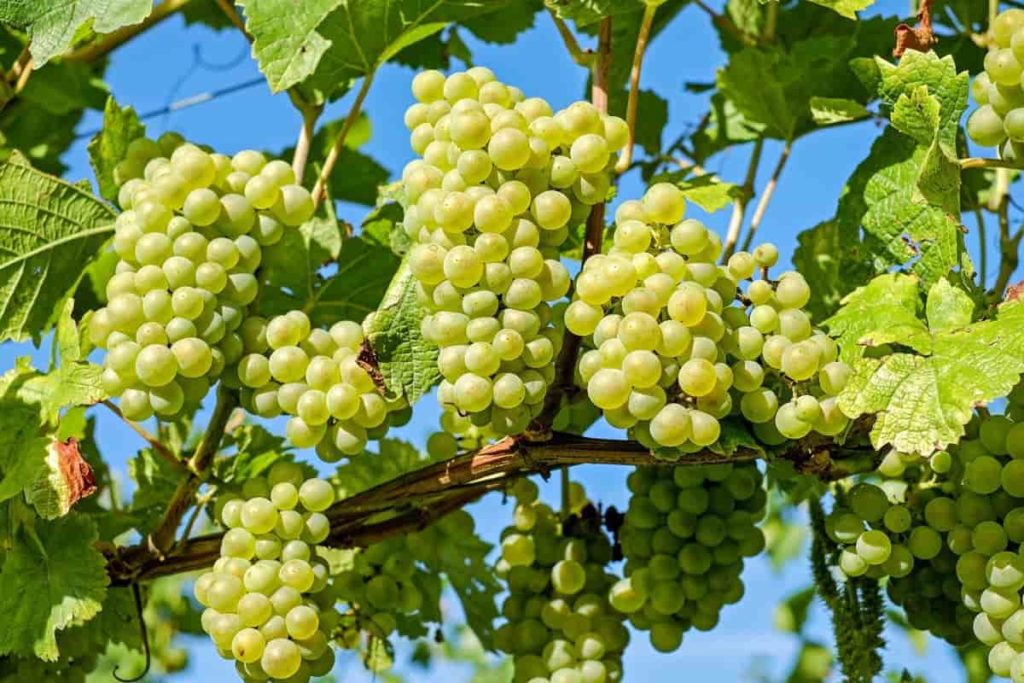
As a deep-rooted, perennial crop, Grapes remove a significant amount of nutrients from the soil and rely on proper nutrient management for what is lost. Factors influencing nutrient removal include rootstock type, type and origin, yield, planting age, weather, soil type, biochemical properties, and interactions. Proper nutrition is key to maximal Grape production. Grapevines generally need more nutrients as they mature.
Fertilization methods in Vineyard aim to improve the supply of soil nutrients available at the level required for growth and production. However, excessive soil nutrients cause Grapes to grow faster while fruit production and quality decrease. A variety of nutrients should be applied to Grapes during the growing season. If a soil test shows that the soil is well-drained, you may want to make a slight mistake when it comes to fertilizing.
Best fertilizer for Grapes
Grapes need macronutrients, including phosphorus, nitrogen, and potassium. Vines also need micronutrients, such as copper, zinc, and iron. Providing the most beneficial nutrients and soil requirements ensures healthy plants that reach their maximum potential. Therefore, you should choose a fertilizer that meets the needs of your Grapes.
Fertilizing Grapevines before planting
If you are still in the planning stages for Grapevines, now is the time to modify the soil. Use a home testing kit to determine your makeup. Generally, but depending on the type of Grape, you want the soil pH to be 5.5 to 7.0 for maximum growth. To increase soil pH, add dolomitic limestone. To lower the pH, modify with sulfur following the manufacturer’s instructions. If your test results show that the soil has a good pH but is deficient in magnesium, add 1 pound (0.5 kg) of Epsom salt for every 100 square feet (9.5 square meters).
In case you miss this: Growing Grapes In Greenhouse – Farming, Cultivation, Production In India
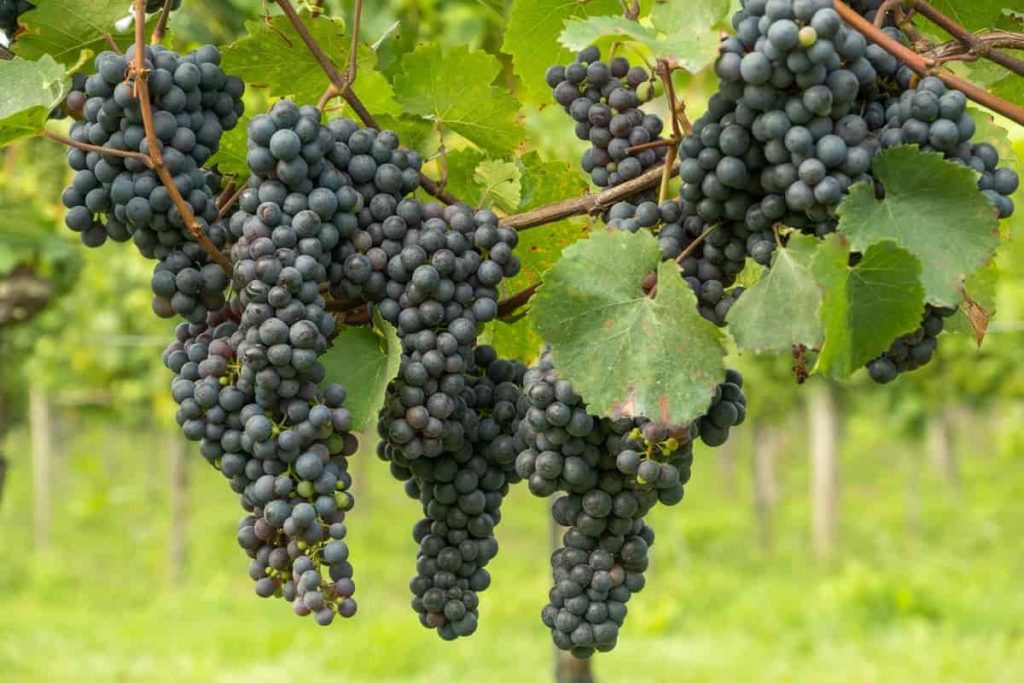
If you find that your soil is deficient in phosphorus, then triple phosphate (0-45-0) at the rate of ½ pound (0.25 kg.), or bone meal (1-11-1) in the amount of 2 ¼ pounds (1 kg.) per 100 square feet (9.5 square meters), superphosphate (0-20-0) at the rate of ¼ pound (0.10 kg.). Finally, if the soil is low in potassium, add ¾ pounds (0.35 kg) of potassium sulfate or 10 pounds (4.5 kg) of green sand.
When to fertilize Grapevines
Feed the Grapevines in early spring when new growth begins and again about a month later, but do not fertilize in mid-summer. Fertilizing too late in the season will promote new, soft growth that can be damaged by early frosts or freezing, which can damage the overall health of your vines.
How to fertilize Grapes
Grapevines, like almost every other plant, need nitrogen, especially in the spring to begin rapid growth. If you want to use fertilizer to feed your Grapevines, apply it in January or February. Apply 5-10 pounds (2-4.5 kg) of poultry or rabbit manure, or 5-20 (2-9 kg) of a steer or cow manure per vine. Other nitrogen-rich Grapevine fertilizers (such as urea, ammonium nitrate, and ammonium sulfate) after the vine has blossomed or when the Grapes are about ¼ inch (0.5 cm.) across.
Add 1/2 pound (0.25 kg) of ammonium sulfate, 3/8 pound (0.2 kg) of ammonium nitrate, or 1/4 pounds (0.1 kg) of urea per vine. Zinc is also good for Grapevines. It helps in many plant functions and its deficiency causes shoots and leaves to break off which results in reduced yields. Spray vine plants with a concentration of 0.1 pounds per gallon (0.05kg/4L.).
In case you miss this: Winter Season Vegetables and Fruits in India
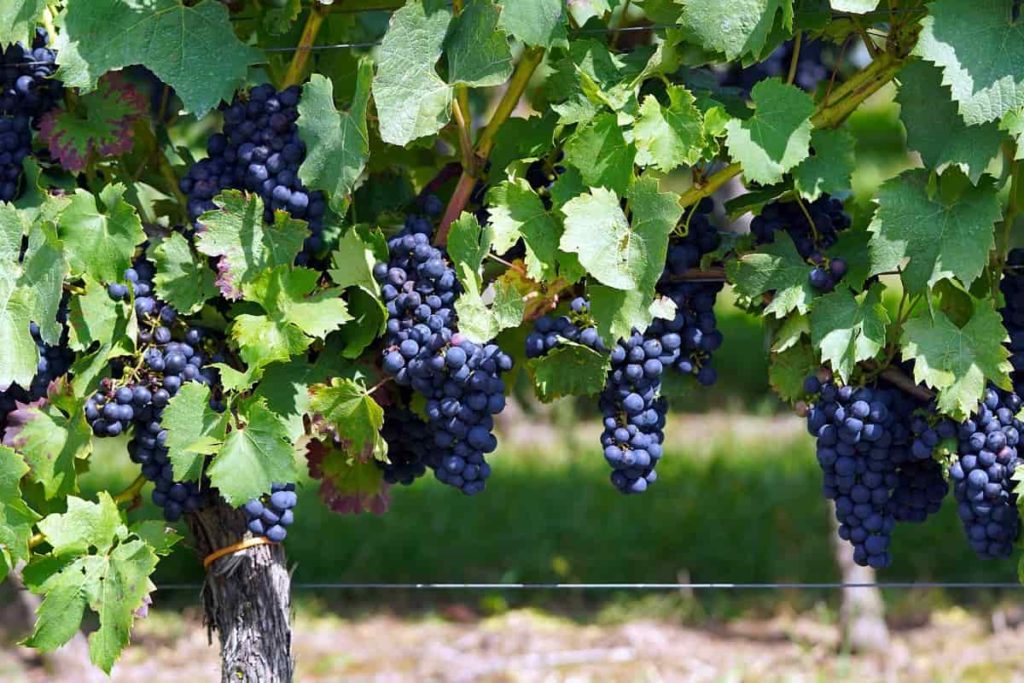
You can also brush the zinc solution on freshly harvested Grapes after harvesting in early winter. Decreased shoot growth, chlorosis (yellowing), and summer burns usually mean potassium deficiency. Apply potassium fertilizer in spring or early summer when the vines are just starting to produce Grapes. Use 3 pounds (1.5 kg) of potassium sulfate per vine for mild reduction or 6 pounds (3 kg) per vine in severe cases.
Best fertilizer for Grapevines
Compost fertilizer
At planting time, add organic plant food as directed on the label and/or mix in some organic matter, such as compost or mushroom compost, at a 25% ratio to the soil removed from the planting hole. Compost is especially useful for heavy clay soils which can retain a lot of water in wet weather and can harden like bricks in the dry season. Mix the composted organic matter well with the local soil in a ratio of 50/50.
Liquid fertilizer for Grapes
If you want to improve the quality and yield of your vineyard, a leading manufacturer and distributor of fertilizers provide fertilizer for Grape crops in both organic and chemical formulas like liquid fertilizer for Grapes or seaweed fertilizer. Liquid fertilizers are classified into two groups: clear solutions and suspensions.
Liquid fertilizers are usually applied by irrigation water (fertigation), spray, knife-in, broadcast, or banded. Unlike solid fertilizers, liquid fertilizers are used on a weight basis and not on a volume basis and are required to calculate the application rate of liquid density (pounds of nutrients per unit volume).
Methods of fertilizer application in Grapevines
The most commonly used methods of fertilization are top dressing, foliar fertilization, and fertigation (injection of water-soluble fertilizers into the irrigation system). Precision agriculture uses advanced technology in the field, which allows producers to accurately measure the needs of any particular vine. As a general rule, at the beginning of the growing period, the plant needs more N to prepare the leaf surface and photosynthesize.
In case you miss this: Vegetable Planting Chart/Calendar in India

During fruit development, plants need potassium to produce well-ripened Grapes. Phosphorus is always needed, as it plays an important role in transporting nutrients. In addition, during the first years after planting, phosphorus helps the plant to develop a healthy root system. In many cases, young plants based on acidic soils cannot make effective use of phosphorus. Thus, many farmers are already planting P2O5. Calcium regulates fruit ripening and coloring and is essential for uniform Grape production.
The first application is performed at the end of the winter season (February) and farmers apply well-rotted manure and plow well with a ripper. After a few weeks, farmers can use urea at the beginning of the growing period, to help the plant produce more leaf surface. Other producers apply N-based foliar fertilization. Other growers also apply well-balanced slow-release granular fertilizers, at the beginning of the growth period. So that the plants have a good time absorbing these nutrients slowly.
In many cases, producers apply KNO3 during maturity. Potassium is thought to help Grapes achieve a deep red color. The type and amount of fertilizer required in a vineyard depend on many different factors. Soil type, plant age, training system, environmental conditions, variety, and vineyard type are all important factors. Plants have different nutritional requirements during different stages of growth.
As the plant matures, potassium requirements are at its core, while nitrogen requirements are minimal. During this stage, the plant provides its nutrients to the fruit to increase its sugar, phenolic, and aromatic substances content. The timing of fertilization also varies in different vineyards. For example, in non-irrigated Grapevine yards, some producers prefer to apply the entire amount of fertilizer during the winter as a slow-release top dressing. In irrigated vineyards, they use 50% N and K, with 75% P and Mg as a top dressing.
They apply the remaining N and P after the fruit set stage, and the remaining K is supplied in 3-4 applications. In areas with high soil CaCO3, Fe deficiency may be observed. In this way, producers can provide chelated iron forms either through fertigation or through foliar spray. Foliar fertilization can help us eliminate short-term deficiencies very quickly. However, it cannot be a substitute for other types of fertilizers in general. Soil use usually has more lasting effects.
In case you miss this: Organic Grapes Farming, Growing Practices
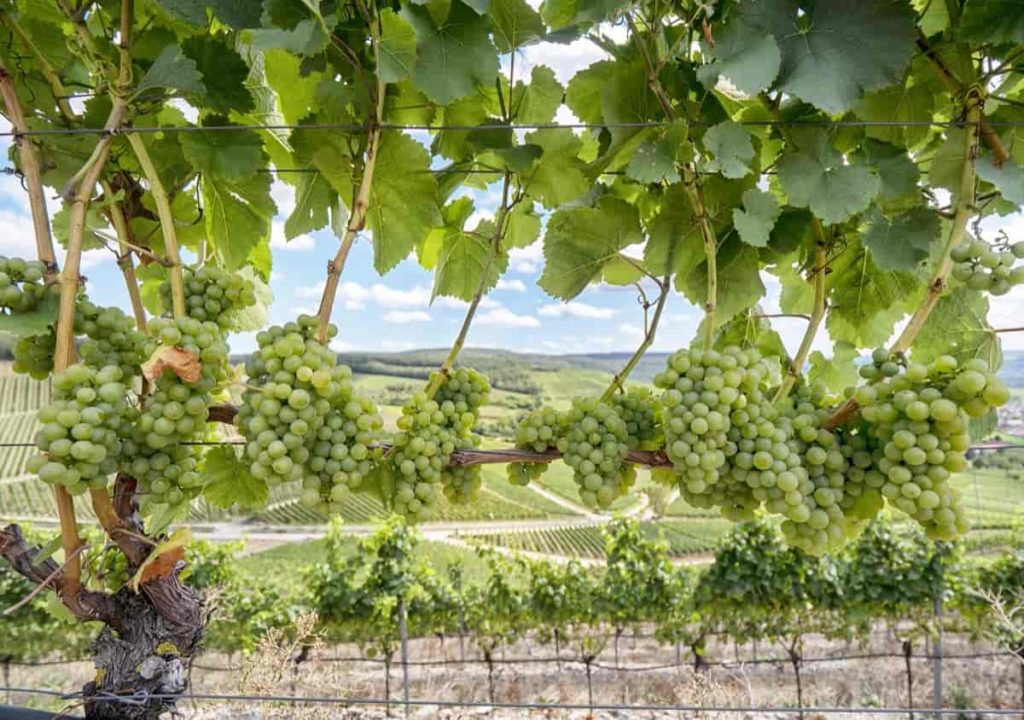
NPK fertilizer schedule
Fertilizer is measured by the content of nitrogen, phosphorus, and potassium or NPK. For Grapes, a ratio of 10-10-10 is sufficient. This means that in a 100-pound bag of fertilizer, there are 10 pounds in each of the three main components. The other is a 70-pound filler that helps spread other nutrients evenly and in the proper amounts. Grapevines thrive in a variety of soil compositions, which means they do not need much help from fertilizer to grow their fruit.
The three main components in 10-10-10 fertilizer do special functions for Grapevines. Nitrogen is essential for fruit growth, and it helps improve leaf quality so that Grapevines can better convert sunlight into nutrients. Phosphorus helps to deepen and strengthen the roots, and ensures that Grapes will produce enough sugar to be sweet and juicy when ripe. Potassium works to make a healthy vine; it helps fight disease. It also helps the vine to grow high-quality Grapes.
Frequently asked questions about fertilizer for Grapevines (FAQ)
How do you fertilize Grapes organically?
Apply nitrogen-rich organic fertilizer two weeks after planting. Apply again each year in early spring before growth begins. Do not apply nitrogen later in the season as it will delay ripening, retain color and produce mild, late-season growth that will deteriorate in winter.
Are coffee grounds good for Grapevines?
Coffee grounds provide many benefits to Grape growers. Their organic matter in the soil helps retain water and acts as a nitrogen-rich fertilizer for the oxen, which encourages growth. Using enough coffee grounds for Grapevines also reduces waste if the ground is thrown in the garbage.
In case you miss this: Grape Plant Grafting Methods; Pruning and Training
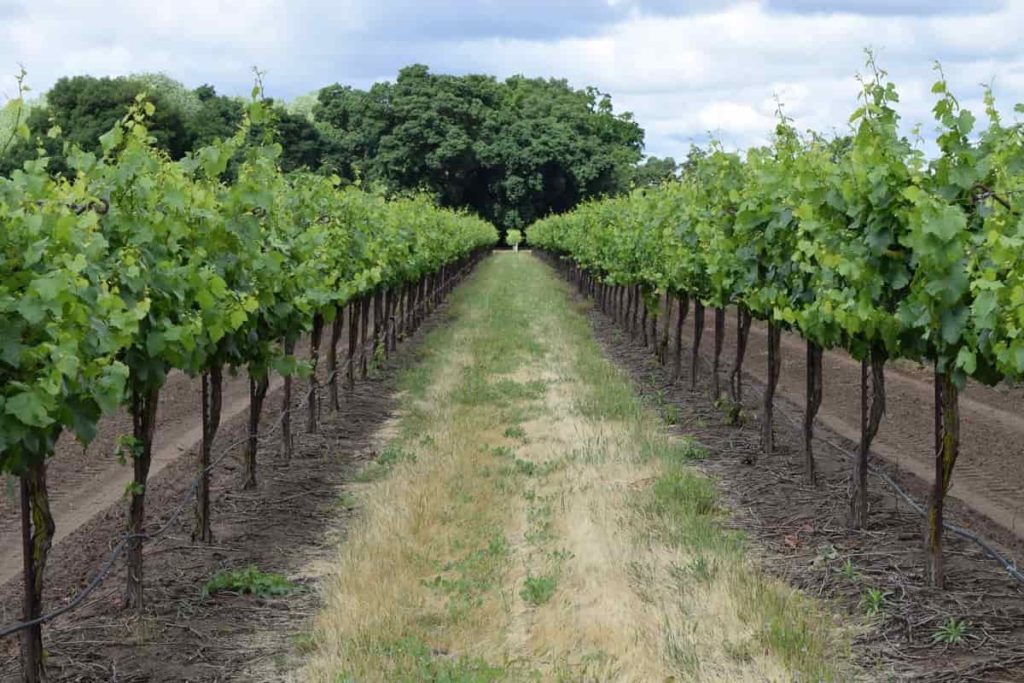
Is Epsom salt good for Grapevines?
If the soil is deficient in magnesium, Epsom salt may be beneficial for Grapevine. But simply using the mixture as a common fertilizer can cause problems for your Grapes.
When should you fertilize vines?
Mix composted organic matter with local soil in a ratio of 50/50. Feed the vines in early spring when new growth begins and again about a month later, but do not fertilize in mid-summer.
Can you over-fertilize Grapevines?
In general, Grapevines are not heavy food and do not require much fertilizer once they are well established. Too much fertilizer can stimulate wood and leaf growth instead of fruit production.
- Types of Pesticides Used in Agriculture: A Beginner’s Guide
- Economical Aquaculture: A Guide to Low-Budget Fish Farming
- 15 Common Planting Errors That Can Doom Your Fruit Trees
- How to Make Houseplants Bushy: Effective Tips and Ideas
- Innovative Strategies for Boosting Coconut Pollination and Yield
- Pollination Strategies for Maximum Pumpkin Yield
- The Complete Guide to Chicken Fattening: Strategies for Maximum Growth
- Natural Solutions for Tulip Problems: 100% Effective Remedies for Leaf and Bulb-Related Issues
- Revolutionizing Citrus Preservation: Towards a Healthier, Greener Future
- Natural Solutions for Peony Leaf and Flower Problems: 100% Effective Remedies
- Maximizing Profits with Avocado Contract Farming in India: A Comprehensive Guide
- Natural Solutions for Hydrangea Problems: 100% Effective Remedies for Leaf and Flowers
- The Ultimate Guide to Choosing the Perfect Foliage Friend: Bringing Life Indoors
- From Sunlight to Sustainability: 15 Ways to Use Solar Technology in Agriculture
- The Ultimate Guide to Dong Tao Chicken: Exploring from History to Raising
- The Eco-Friendly Makeover: How to Convert Your Unused Swimming Pool into a Fish Pond
- Mastering the Art of Delaware Chicken Farming: Essentials for Healthy Backyard Flocks
- 20 Best Homemade Fertilizers for Money Plant: DIY Recipes and Application Methods
- How to Craft a Comprehensive Free-Range Chicken Farming Business Plan
- Brighten Your Flock: Raising Easter Egger Chickens for Beauty and Bounty
- How to Optimize Your Poultry Egg Farm Business Plan with These Strategies
- Subsidy for Spirulina Cultivation: How Indian Government Schemes Encouraging Spirulina Farmers
- Ultimate Guide to Raising Dominique Chickens: Breeding, Feeding, Egg-Production, and Care
- Mastering the Art of Raising Jersey Giant Chickens: Care, Feeding, and More
- Ultimate Guide to Raising Legbar Chickens: Breeding, Farming Practices, Diet, Egg-Production
- How to Raise Welsummer Chickens: A Comprehensive Guide for Beginners
- How to Protect Indoor Plants in Winter: A Comprehensive Guide
- Ultimate Guide to Grow Bag Gardening: Tips, Tricks, and Planting Ideas for Urban Gardeners
- Guide to Lotus Cultivation: How to Propagate, Plant, Grow, Care, Cost, and Profit
- Agriculture Drone Subsidy Scheme: Government Kisan Subsidy, License, and How to Apply Online
- Ultimate Guide to Raising Araucana Chickens: Breed Profile, Farming Economics, Diet, and Care
- Bringing Hydroponics to Classroom: Importance, Benefits of Learning for School Students
- Ultimate Guide to Raising Polish Chickens: Breed Profile, Farming Economics, Diet, and Care
- Ultimate Guide to Raising Australorp Chickens: Profile, Farming Economics, Egg Production, Diet, and Care
- Silkie Chicken Farming: Raising Practices, Varieties, Egg Production, Diet, and Care
- Sussex Chicken Farming: Raising Practices, Varieties, Egg Production, Diet and Care